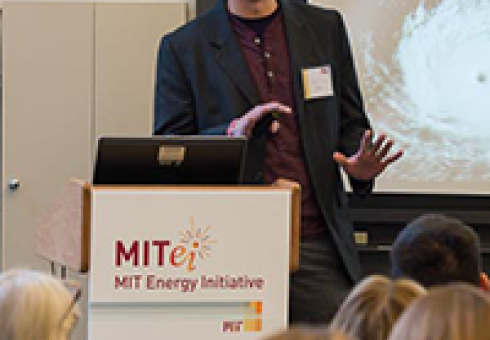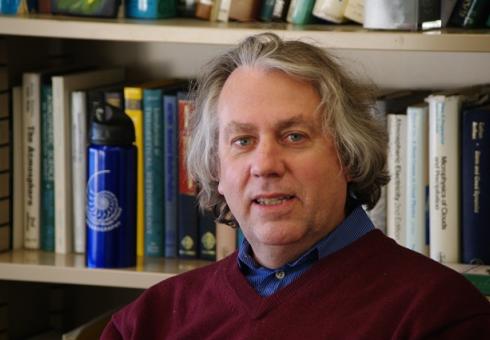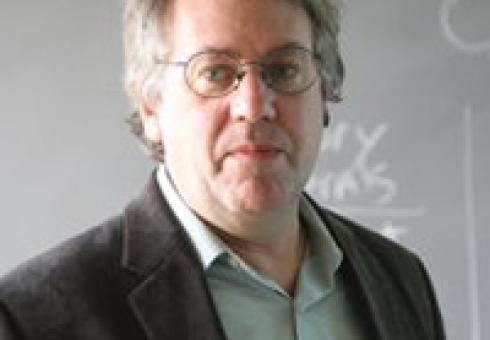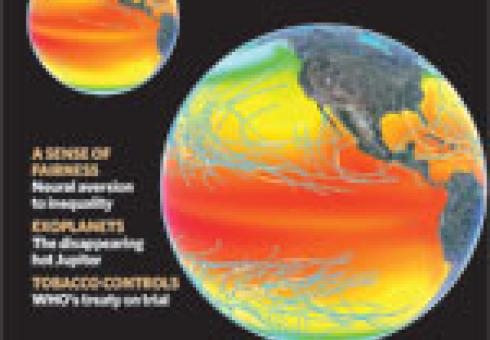Nature: Natural hazards: New York vs the sea
By: Jeff Tollefson
February 13, 2013
In the wake of Hurricane Sandy, scientists and officials are trying to protect the largest US city from future floods.
Joe Leader's heart sank as he descended into the South Ferry subway station at the southern tip of Manhattan in New York. It was 8 p.m. on 29 October, and Hurricane Sandy had just made landfall some 150 kilometres south in New Jersey. As chief maintenance officer for the New York city subway system, Leader was out on patrol. He had hoped that the South Ferry station would be a refuge from the storm. Instead, he was greeted by wailing smoke alarms and the roar of gushing water. Three-quarters of the way down the final set of stairs, he pointed his flashlight into the darkness: seawater had already submerged the train platform and was rising a step every minute or two.
“Up until that moment,” Leader recalls, standing on the very same steps, “I thought we were going to be fine.”
Opened in 2009 at a cost of US$545 million, the South Ferry station is now a mess of peeling paint, broken escalators and corroded electrical equipment. Much of Manhattan has returned to normal, but this station, just blocks from one of the world's main financial hubs, could be out of service for 2–3 years. It is just one remnant of a coastal catastrophe wrought by the largest storm in New York's recorded history.
Sandy represents the most significant test yet of the city's claim to be an international leader on the climate front. Working with scientists over the past decade, New York has sought to gird itself against extreme weather and swelling seas and to curb emissions of greenhouse gases — a long-term planning process that few other cities have attempted. But Sandy laid bare the city's vulnerabilities, killing 43 people, leaving thousands homeless, causing an estimated $19 billion in public and private losses and paralysing the financial district. The New York Stock Exchange closed for the first time since 1888, when it was shut down by a massive blizzard.
As the humbled city begins to rebuild, scientists and engineers are trying to assess what happened during Sandy and what problems New York is likely to face in a warmer future. But in a dilemma that echoes wider debates about climate change, there is no consensus about the magnitude of the potential threats — and no agreement about how much the city should spend on coastal defences to reduce them.
On 6 December, during his first major public address after the storm, New York mayor Michael Bloomberg promised to reinvest wisely and to pursue long-term sustainability. But he warned: “We have to live in the real world and make tough decisions based on the costs and benefits.” And he noted that climate change poses threats not just from flooding but also from drought and heat waves. The city must be mindful, he said, “not to fight the last war and miss the new one ahead”.
Calculated risks
In the immediate aftermath of Sandy, lower Manhattan looked like a war zone. Each night, streams of refugees wielding flashlights wandered north out of the blackout zone, where flood waters had knocked out an electrical substation.
The storm devastated several other parts of the city as well. In Staten Island, pounding waves destroyed hundreds of homes, and one neighbourhood in Queens burned to ashes after water sparked an electrical fire. Power outages lasted for more than two weeks in parts of the city. Chastened by the flooding and acutely aware that Hurricane Irene, in 2011, was a near miss, the city is now wondering what comes next.
“Is there a new normal?” asks John Gilbert, chief operating officer of Rudin Management, which manages several office buildings in downtown New York. “And if so, what is it?” Gilbert says that the company is already taking action. At one of its buildings, which took on some 19 million litres of water, the company is moving electrical systems to the second floor. “You have to think that as it has happened, it could happen again,” he says. “And it could be worse.”
At Battery Park, near the South Ferry station, the storm surge from Sandy rose 2.75 metres above the mean high-water level — the highest since gauges were installed there in 1923. In a study published last week in Risk Analysis, researchers working with data from simulated storms concluded that a surge of that magnitude would be expected to hit Battery Park about once every 500 years in the current climate (J. C. J. H. Aerts et al. Risk Anal. http://dx.doi.org/10.1111/risa.12008; 2013).
But the study authors and other scientists say that the real risks may be higher. The study used flooding at Battery Park as a measure of hurricane severity, yet it also showed that some storms could cause less damage there and still hammer the city elsewhere. Factoring in those storms could drive up the probability estimates of major hurricane damage to New York.
The 1-in-500 estimate also does not take into account the unusual nature of Sandy. Dubbed a Frankenstorm, Sandy was a marriage of a tropical cyclone and a powerful winter snowstorm, and it veered into the New Jersey coast along with the high tide of a full Moon. “It was a hybrid storm,” says Kerry Emanuel, a hurricane researcher at the Massachusetts Institute of Technology (MIT) in Cambridge and one of the study's co-authors. “We need to understand how to assess the risks from hybrid events, and I'm not convinced that we do.”
The risks will only increase as the world warms. The New York City Panel on Climate Change's 2010 assessment suggests that local sea level could rise by 0.3–1.4 metres by 2080. Last year, Emanuel and his colleagues found that floods that occur once every 100 years in the current climate could happen every 3–20 years by the end of this century if sea level rises by 1 metre. What is classified as a '500-year' event today could come every 25–240 years (N. Lin et al. Nature Clim. Change 2, 462–467; 2012).
For city planners, the challenge is to rebuild and protect the city in the face of scientific uncertainty. A few scientists have said for more than a decade that the city should armour New York's harbour with a storm-surge barrier similar to the Thames barrier in London. In Sandy's wake, that idea has gained renewed interest, and a New York state panel last month called for a formal assessment of it.
Bridges and barriers
Malcolm Bowman, who heads the storm-surge modelling laboratory at the State University of New York at Stony Brook, has spearheaded the drive for barriers. He imagines a structure roughly 8 kilometres wide and 6 metres high at the entrance to the harbour, and a second barrier where the East River drains into the Long Island Sound. The state panel's cost estimates for such a system range from $7 billion to $29 billion, depending on the design. The harbour barrier could also serve as a bridge for trains and vehicles to the city's airports, suggests Bowman. “My viewpoint is not that we should start pouring concrete next week, but I do think we need to do the studies,” he says. But whether Sandy will push the city to build major defences, Bowman says, “I don't know.”
Disasters have spurred costly action in the past. The 1888 blizzard helped to drive New York to put its elevated commuter trains underground. And in 2012, the US Army Corps of Engineers completed a $1.1-billion surge barrier in New Orleans, Louisiana, as part of a $14.6-billion effort to protect the city after it was battered by hurricanes Katrina and Rita in 2005. But the New York metropolitan area is bigger and more complex than New Orleans, and protecting it will require a multi-pronged approach. Several hundred thousand city residents live along more than 800 kilometres of coastline, and a barrier would not protect much of coastal Long Island, where Sandy wrought considerable damage. Moreover, the barrier would work only against occasional storm surges. It would not hold back the slowly rising sea or protect against flooding caused by rain.
“A storm-surge barrier may be appropriate, but it's never one thing that is going to protect you,” says Adam Freed, a programme director at the Nature Conservancy in New York, who until late last year was deputy director of the city's office of long-term planning and sustainability. “It's going to be a holistic approach, including a lot of unsexy things like elevating electrical equipment out of the basement and providing more back-up generators.”
As part of that holistic effort, officials are exploring options for expanding the remaining bits of wetlands that once surrounded the city and buffered it from storms. In his address, Bloomberg called wetlands “perhaps the best natural barriers against storms that we have”.
But most of the city's wetlands have become prime real estate in recent decades, and Sandy made clear the consequences of developing those areas, says Marit Larson, director of wetlands and riparian restoration for the New York parks department.
A few weeks after the storm, Larson parks her car near the beach on Staten Island and looks out at a field of Phragmites australis, a common marsh reed. The field is part of Staten Island's 'Bluebelt' programme, initiated in the late 1980s to promote wetlands and better manage storm-water runoff. But the patch of wetlands here is smaller than a football pitch, and Sandy's surge rolled over it, damaging the nearby row houses. “If you look at the historical maps,” says Larson, “everything that used to be a wetland got wet.”
New York is now moving to strengthen its network of existing wetlands, which cover some 2,300–4,000 hectares. The mayor's budget plan for 2013–17 includes more than $200 million to restore wetlands as part of an effort to protect and redesign coastal developments.
Sandy also showed how proper construction can help to reduce risks from future storms. In one Staten Island neighbourhood, a battered roof rests on the ground, marking the spot where an ageing bungalow once stood. Next door, a newer house still stands, with no apparent damage apart from a flooded garage — sturdy proof of the value of modern building codes. In New York, newer buildings constructed in 100-year-flood zones, which are defined by the US Federal Emergency Management Agency (FEMA), cannot have any living spaces or major equipment, such as heating units, below the projected flood level (see 'Danger zone').
The city's zoning provisions could not protect against a storm like Sandy: officials estimate that two-thirds of the homes damaged by the storm were outside the 100-year-flood area. But scientists say that the FEMA flood maps were out of date, so even century-scale storms could cause damage well beyond the designated areas. Last month, FEMA began releasing new flood maps for the New York region that substantially expand this zone.
In their latest study, Emanuel and his colleagues estimate the average annual flood risk for New York as only $59 million to $129 million in direct damages. But costs could reach $5 billion for 100-year storms and $11 billion for 500-year storms. These figures do not include lost productivity or damage to major infrastructure, such as subways.
Bowman and other researchers argue that the city should commit to protecting all areas to a 500-year-flood standard, but not all the solutions are physical. A growing chorus of academics and government officials stress that the city must also bolster its response capacity and shore up the basic social services that help people to rebuild and recover.
Most importantly, the city and surrounding region need to develop a comprehensive strategy for defending the coastline, says Jeroen Aerts, a co-author of the Risk Analysis assessment who studies coastal-risk management at VU University in Amsterdam. Aerts is working with New York officials to analyse proposals for the barrier system and a suite of changes in urban planning, zoning and insurance. “You need a master plan,” he says.
“Ultimately, we all have to move together to higher ground.”
Seth Pinsky is working towards that goal. As president of the New York City Economic Development Corporation, he was tapped by Bloomberg to develop a comprehensive recovery plan that will make neighbourhoods and infrastructure safer. He points out that some newer waterfront parks and residential developments along the coast fared well during the storm. For example, at Arverne by the Sea, a housing complex in Queens, Pinsky says that units survived because they are elevated and set back from the water, with some protection from dunes. The buildings suffered little damage compared with surrounding areas.
Intelligent design
The cost of strengthening the city will be astronomical. In January, Congress approved some $60 billion to fund Sandy recovery efforts, with around $33 billion for longer-term investments, including infrastructure repair and construction by the Army Corps of Engineers. Pinsky says that he does not yet know how much of that money will go to New York, but he is sure it will not be enough. The city will define its budget in June, after his group has made its official recommendations. The rebuilding endeavour will probably necessitate a “creative” mix of public and private financing, he says. “It will probably require calling on a combination of almost every tactic that has been tried around the world.”
Even as he calls for more intelligent development, Pinsky says that New York is unlikely to take a drastic approach to dealing with storm surge and sea-level rise. “Retreating from the coastline of New York city both will not be necessary and is not really possible,” he says.
Given the sheer scale of development along the coast, it is hard to argue with Pinsky's assessment. But many climate scientists fear that bolstering coastal developments only delays the eventual reckoning and increases the likelihood of future disasters. The oceans will rise well into the future, they say, so cities will eventually be forced to accommodate the water.
“I don't see anything yet that looks towards long-term solutions,” says Klaus Jacob, a geoscientist at Columbia University's Lamont-Doherty Earth Observatory in Palisades, New York. But Jacob admits that he is as guilty as anyone. In 2003, he and his wife bought a home in a low-lying area on the Hudson River in Piermont, New York. Although it went against his professional principles, he agreed to the purchase with the assumption that he could elevate the house. But height-restriction laws prevented him from doing so, and Sandy flooded the house. The couple are now rebuilding.
“In a way, I think I was in denial about the risk,” Jacob says. He hopes that a new application to raise the house will be approved, but he still fears that the neighbourhood will not survive sea-level rise at the end of the century. New Yorkers and coastal residents everywhere would be wise to learn that lesson. “Ultimately,” Jacob says, “we all have to move together to higher ground.”
Nature 494, 162–164 (14 February 2013) doi:10.1038/494162a
















 The Dalai Lama called for increasingly enlightened stewardship of Earth’s environment and resources in public remarks on the MIT campus on Monday.
The Dalai Lama called for increasingly enlightened stewardship of Earth’s environment and resources in public remarks on the MIT campus on Monday.




